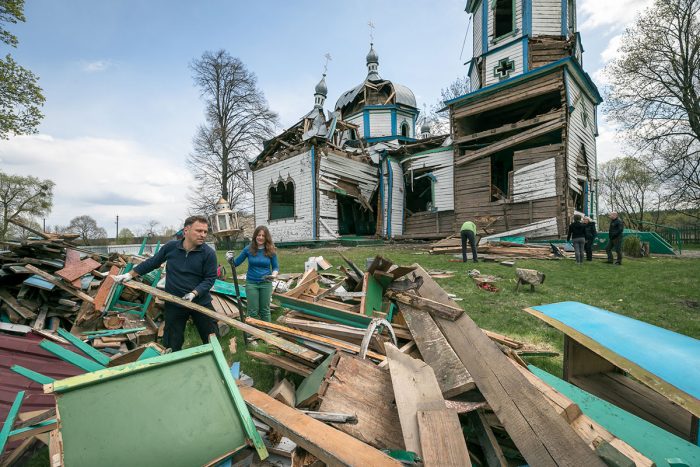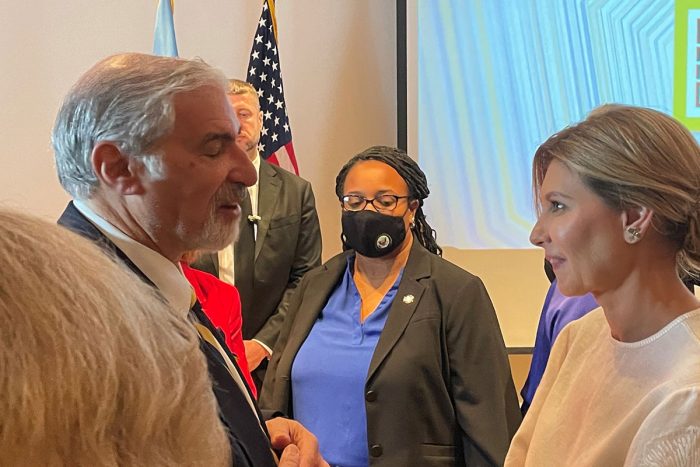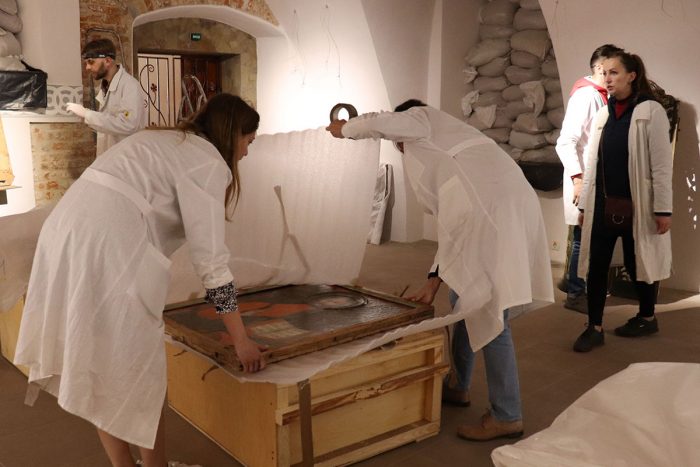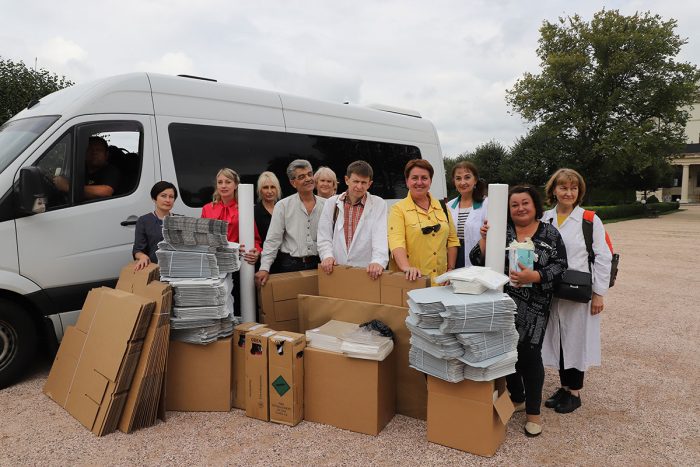Saving Ukrainian Cultural Heritage in Times of War
Richard Kurin reports on a recent conference focused on efforts to the Smithsonian’s and others’ efforts to save Ukraine’s cultural heritage from destruction.

Last month, the Ukrainian Museum in New York City hosted a special event, Saving Ukrainian Cultural Heritage in Times of War, for museum and cultural leaders as part of the United Nations General Assembly week. I was honored to join Ukrainian First Lady Olena Zelenska and Ambassador Oksana Markarova as featured speakers. We argued that, with the destruction of museums, archives, libraries, cultural and religious sites, theaters, and other places of social significance, the Russian military is attempting to erase a people, to purposefully eliminate the sense and spirit of their claim to nationhood and sovereignty.
Following greetings by the museum’s director and board chair, Ambassador Markarova set the context of cultural destruction in the midst of the Russian Federation’s invasion of Ukraine. First Lady Zelenska spoke eloquently of the importance of history, art, and culture in defining the identity of the Ukrainian people. This identity is indeed an explicit target of Putin’s war, she said. Ukrainians are fighting for their freedom, and in particular their freedom to be who they culturally are.

As I explained in my presentation, the Smithsonian had been following events in Ukraine for several years, particularly since the 2014 conflict in Crimea and the Donbas. Our main link was Ihor Poshyvailo, the director of the Maidan Museum in Kyiv and a former fellow at the Center for Folklife and Cultural Heritage in 2009 and 2010.
Ihor had viewed the Smithsonian’s efforts to help save cultural heritage in Haiti after the massive January 2010 earthquake. That effort, coordinated with Haitian leaders including Patrick Delatour, Patrick Villaire, and Olsen Jean Julien who had curated and coordinated the Haiti program at the 2004 Smithsonian Folklife Festival, deployed scores of Smithsonian and other conservators to a temporary cultural recovery base in Haiti, and resulted in saving some 35,000 artworks, artifacts, and archives, recovering galleries, museums, and repositories, training more than 100 Haitians in conservation, and establishing a permanent cultural center at Quisqueya University.

The Haiti effort spawned the Smithsonian Cultural Rescue Initiative (SCRI) led by Cori Wegener, a curator and U.S. Army reservist “monuments woman” who had helped stabilize the Iraqi Museum after the U.S. invasion. Ihor participated in SCRI’s training program and later became one of its trainers, preparing key cultural first responders around the world on how to plan for and deal with cultural crises wrought by conflict and natural disaster.
SCRI, working with partners including the Prince Claus Fund Cultural Emergency Response and the Aliph Foundation, held almost daily Zoom talks with Ihor at the onset of the February invasion . The Smithsonian, along with others, provided materials and supplies to his Heritage Emergency Response Initiative—a concerted effort to safeguard, pack, and transport endangered artworks and artifacts in Ukrainian institutions. Ihor and his team identified needs—fire extinguishers, crates, boxes, and other materials—and delivered them to colleagues across the country. They also visited damaged sites to clear debris and recover collections.
Svitlana Strelnikova and her staff of expert conservators at the National Research and Restoration Center with facilities in Kyiv, Kharkiv, Odesa, and Lviv were charged with caring for Ukrainian national collections. But with museums and others evacuating collections to safe-haven storage, and her center lacking vehicles, Svitlana and her team had no way to reach those collections. With U.S. State Department aid, the Smithsonian enlisted Uber to provide almost daily van transportation across Ukraine, delivering needed equipment and supplies and enabling groups of conservators to service stored but still endangered collections.
The Smithsonian has also worked closely with Ukrainian Deputy Minister of Culture Kateryna Chuyeva and others, including UNESCO, to provide information and advice to Ukrainian cultural colleagues: how to quickly pack several hundred paintings, how to move large sculptures, how to prepare collections for a winter with no heat. Smithsonian conservators from the American Art Museum, the Museum Conservation Institute, the National Museum of Asian Art, Smithsonian Libraries, and other organizations have offered guidance via Zoom calls with scores of Ukrainian professionals.

Among the most groundbreaking work we have been doing is satellite monitoring and analysis of physical damage and destruction. Using methods we developed for monitoring ISIS destruction in Syria and Iraq, the Smithsonian partners with the Virginia Museum of Natural History to run the Cultural Heritage Monitoring Lab. We are tracking some 28,000 cultural sites in Ukraine—religious sites, monuments, memorials, museums, libraries, performing arts venues, archaeological and historical sites. We have access to U.S. satellites including several that detect heat signatures from bombs and artillery and can thus correlate attacks with those cultural sites to identify possible damage and destruction.
With scholars from the Universities of Maryland and Pennsylvania, we work closely with the Departments of State and Defense and Ukrainian officials to document incidents and gather evidence of war crimes through satellite remote sensing and imaging. As of August 31, we had confirmed that 207 cultural sites were damaged or destroyed and provided evidence of potential damage to 1,501.
We also consult with our colleagues in the Department of Homeland Security and the FBI to share information about the looting and trafficking of cultural property. Additionally, we work with U.S. intergovernmental groups, the Cultural Heritage Coordinating Committee and the Scientific Collections working group with the White House Office of Science and Technology Policy, to coordinate efforts and share information.

First Lady Zelenska was impressed with our work and thanked us for aiding efforts to protect and preserve Ukrainian culture now under attack. I had the opportunity to speak with her and the ambassador about the continuing creativity of Ukrainians in light of the war. Ukrainians have taken to the streets to play their instruments and sing their songs, relying on their culture for strength and resilience in their struggle. And they have been amazingly creative, crafting jewelry and embroidering clothing and developing all sorts of grassroots cultural expressions.
At the session, First Lady Zelenska signed and postmarked a first-day cover of a new Ukrainian postal stamp dedicated to philosopher Hryhorii Skovoroda, while we livestreamed a simultaneous ceremony at the site of his namesake museum, whose horrific destruction our team had documented. The first-day cover was then donated to the Smithsonian’s National Postal Museum.
In our conversation, I also requested that she and President Zelensky sign and donate to the Smithsonian a first-day cover of the “Russian warship, go f*** yourself” stamp issued by Ukraine in March. That stamp was inspired by the response of a Ukrainian guardsman on tiny Snake Island in the Black Sea to a demand of surrender by Russian forces early in the war. Ukrainian forces on the island were thought to have been killed, but it turned out they had survived. Their response became a rallying cry for Ukrainian resistance to the invasion—a great example of how an informal cultural expression becomes, in dramatic times, enshrined as the contemporary folklife of a people.
Learn more
Richard Kurin is the Smithsonian’s Distinguished Scholar and Ambassador at Large and interim director of the Center for Folklife and Cultural Heritage, which he formerly headed for two decades.
The Smithsonian’s efforts in Ukraine are supported by congressionally appropriated funds, the U.S. Department of State, Bank of America, the Rockefeller Foundation, the Mellon Foundation, the Omidyar Group, Ed and Helen Hintz, Brad Freeman, the Roberts family, and the Kosciuszko Foundation.
This is a lightly edited version of a post that was first published by the Smithsonian’s Center for Folklife and Cultural Heritage.
Posted: 25 October 2022
-
Categories:
Art and Design , Collaboration , Education, Access & Outreach , Feature Stories , History and Culture







